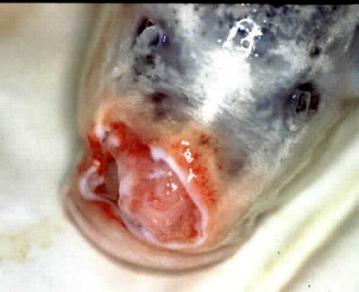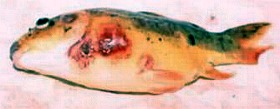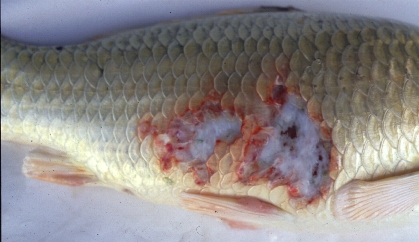Bacterial ulcers a common, but difficult problem
Bacterial ulcers are a common fish disease problem, particularly with ornamental pond fish such as goldfish and koi. They are one of the most difficult problems to deal with, especially if large numbers of fish are affected. Dealing effectively with bacterial ulcers can be time-consuming and really requires a high degree of skill and experience. However, unlike bacterial gill diseases, the success rate can be very high even with quite severe and advanced cases.
Bacterial ulceration |
|
 |
|
 Typical cases of ulcers on koi carp. The area of erosion in both cases is quite extensive. The lesions are deep, exposing the muscle underneath. The margin of inflammation can be clearly seen around the lesion. Both fish recovered following combination topical treatment and antibiotic injections Typical cases of ulcers on koi carp. The area of erosion in both cases is quite extensive. The lesions are deep, exposing the muscle underneath. The margin of inflammation can be clearly seen around the lesion. Both fish recovered following combination topical treatment and antibiotic injections |
|
|
photos: Frank Prince-Iles |
|
What are ulcers?
An ulcer is defined as a break in the skin extending through all the layers, which fails to heal and is often accompanied by inflammation. The typical skin ulcer has a central area of tissue erosion that may be shallow or deep – in many cases exposing the underlying muscle. Around the edge of the lesion is usually an area of whitish necrotic (dead) tissue and debris, with a large outer zone of inflammation extending into healthy tissue. The scales surrounding the lesion may be raised or infected. Without treatment it gets progressively bigger. In most, but not all, cases they are caused by opportunistic bacteria already in the pond or tank.
Bacterial Ulceration |
|
 Severe ulceration on the body of a koi. A close view of the photo shows many infected scales around the lesion which had to be removed to facilitate healing. This fish recovered after three weeks of intensive treatment Severe ulceration on the body of a koi. A close view of the photo shows many infected scales around the lesion which had to be removed to facilitate healing. This fish recovered after three weeks of intensive treatment |
|
How are ulcers caused?
They can be caused by damage to the skin from parasites or chemicals (for example exposure to high levels of ammonia or nitrite or high/low pH). Fish can also be susceptible if their normal defences are compromised by stress. High numbers of opportunistic bacteria, such as would be found in water with a high organic content or other diseased fish, also increase the risk of infection.
If just one is affected it is probably due to a health problem specific to that individual. However if several are affected it is quite likely that there is an underlying environmental problem. In this quite common situation it is no good simply throwing in some anti-bacterial treatment and hoping. It is important to establish and resolve the underlying cause, be it water quality or parasites, as well as treating the bacterial infection.
Treatment
It is hard to give a general answer because it really depends on the circumstances surrounding each case. If just one individual is affected and assuming that it has been diagnosed at an early stage, simply dealing with any other health problems and treating the lesion topically may suffice. Improving the koi environment is also imperative.
If several are affected it is vital that the system and all of the fish are examined, either in or out of the water, to determine the full extent of the spread of the infection.
My own experience is that the chances of survival are greatly improved by a thorough debridement of the lesion together with topical treatment. This is an important step irrespective of any other treatments used.
Treat all the affected fish
It is often the case that there are many more infected fish than initially thought. It is important that all of those affected are treated at the same time otherwise the untreated fish will in turn get worse as well as acting as a reservoir of infection. This is often the situation where an outbreak of bacterial disease goes on for months, despite continually treating the most obviously affected individuals. To the owner it looks like fresh outbreaks despite his best efforts, when it is really just an ongoing chronic infection.
As far as treatments are concerned this is really a matter of judgment based on the severity of the situation. The options are topical treatments, medicated food, bath treatments (short duration or long term) or antibiotic injections. Whatever course of treatment is decided the aim should be to resolve the problem within a matter of 2-3 weeks. If there is not a marked improvement during that time then either the treatment plan needs reappraising or there are still underlying problems that haven’t been tackled.
Aim for a 90% survival rate or higher
I should stress the importance of tackling bacterial diseases such as ulcers in a systematic, thorough way. Simply applying dartboard medication, in which a range of different treatments is tried in succession, is unlikely to work and in all probability will simply make matters worse. When dealing with bacterial ulcers we should be looking for at least a 90% survival rate. If the survival rate is significantly less than this it is most likely due to inappropriate treatment rather than bacterial infection
If the survival rate is significantly less than this it is most likely due to inappropriate treatment rather than bacterial infection
Link: ANTIBIOTIC BATHS >

